1925: Hicksville Builds A New High School

The village of Hicksville changed quickly in the years that followed World War I. As local agriculture began to slowly fade, and as New York's appetite for suburbs increased, the village's population grew. It became clear that the school building on Nicholai Street was inadequate.
By 1921, the shortage of student space was alarming. Kindergarten had been relocated from the school proper to a spare room in the Fire House (i.e., the building which had opened in 1906) on West Marie Street.


In violation of New York State regulations, 100 students in the school had been assigned seats not in classrooms, but rather in the auditorium. Even worse, another 100 students had no permanent locations in the school that could be considered "theirs." A representative of the State Department of Education advised Hicksville's Board of Education that the school building was not suitable for conversion to a high school that would meet state standards. He recommended building a new school, with large outdoor space for play and athletics, to house all Hicksville students in Grades 7 through 12.
The Board promptly solicited offers of land for the High School. The minimum size was 5 acres, but 10 acres would be preferred. By March 1922, a site had been identified, and negotiations to purchase it began.
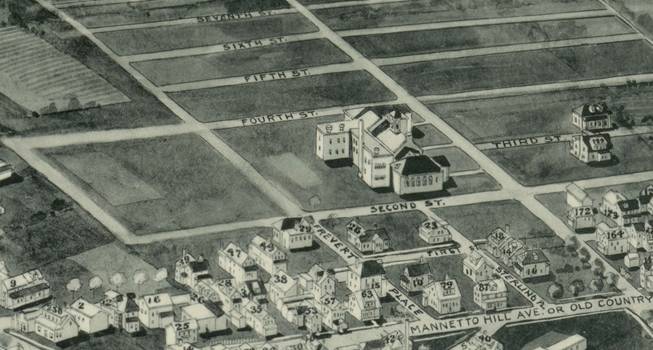
The above snapshot from the 1925 Aero-View of Hicksville (Library of Congress website)) shows how residential development was already encroaching on old farmland, and how close the chosen site was to both existing homes and to future development to the south.

Over the many months that negotiations for the site continued, the Board engaged the services of architects, and plans for the building evolved. I have not been able to determine how the architects - brothers H. Errol Coffin and Kenneth Ford Coffin, both graduates of Cornell - were selected. Their partnership, formed in 1919, was too new to have much of a track record. Later on, the firm went on to distinguish itself over many decades as specialists in educational buildings, designing structures for (among other places) Mattituck, Farmingdale, Glen Cove, Cornell University, and for towns in upstate New York, northern New Jersey, Peru, and Chile.
Discussions between the Board and the architects seem to have been less transparent than the earlier parts of the process. The Long Islander (a newspaper published in Huntington, which is the source for much of this article's content) spoke only in general terms about "plans" and "revised plans," but it did not divulge specifics, instead recommending that those who were interested attend the Board of Education meetings.
When finally acquired, the site comprised 15 acres, more than originally contemplated (of course, many years later the additional acres would provide useful spots for those wonderful additions and the infamous temporaries). By February 1923, all issues related to title of the land had been resolved, and the specifications for bids on construction were being prepared.
In May, taxpayers approved ("unanimously" per the Long Islander, although the vote was actually 86 for, 1 against) an appropriation of $250,000 for the High School building. This amount is curious, for the estimate would have been derived in consultation with the architects, based on their plans and their expert knowledge of construction - yet within months, the estimate ballooned upward by 40%. Either the Board had expanded its requirements following the appropriation, or the architects had been unaware of the cost of their design. Regardless, the Board chose to proceed with it as it was, rather than seeking a less expensive design in line with the appropriation. In November 1923, the Freeport Daily Review noted that none of the contractors' bids had been within the original budget, and that Hicksville's taxpayers had been forced to reconvene, this time voting 143 to 7 in favor of appropriating a further $95,000.
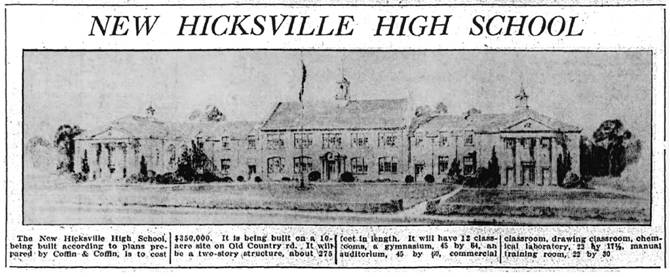
In December the general public got its first glimpse of the future High School when the Brooklyn Eagle published an architect's rendering (above). The caption rounded the cost up to $350,000, and it disclosed some details that had not been published locally: there would be 12 regular classrooms, a gymnasium, a commercial classroom, a room for drawing, a chemistry lab, and a "manual training" room.

A few days before the picture appeared in the Eagle, 300 High School students, teachers, and officials had marched from the old school to the site of the new school. After speeches by a representative of the Board of Education and by each of the four High School Class Presidents, ground was officially broken by one Mr. John Hahn, reportedly given the honor because he was among "the oldest residents of the village present" at the ceremony. In reality, he was a prominent citizen, a successful insurance broker and real estate agent who 15 years earlier had worked with other local "movers and shakers" trying to build a trolley line between Hicksville and Amityville. Per the data recorded on the 1925 State Census, the supposedly aged Mr. Hahn was only about 62 years old at the time of the groundbreaking.
Within 2 months, the foundations were poured, and the first floor's masonry work was in-progress. As the building took shape, someone - it is not clear who, whether architect or Board member - looked things over and decided that an additional staircase, not part of the specified design, should be added to the building, and all parties agreed to the change.

Despite the increased appropriation, money for some items - as often happens today - had to come from other sources. Among these items was the flag pole; the Charles Wagner American Legion Post agreed to undertake its funding. One of the Post's fundraisers for this purpose was a theatrical production staged by the Ladies Auxiliary, whose members were tutored for the occasion by a highly-regarded actor of the day.
Construction on the building progressed so quickly that on April 26, 1925, the cornerstone had to be laid earlier than first planned (i.e., part of the construction would have had to be delayed if the cornerstone was not in place by May). At this point, the second-level floor and walls were taking shape. The rapid pace continued over the summer, so that by September, the new High School was ready to accept students.
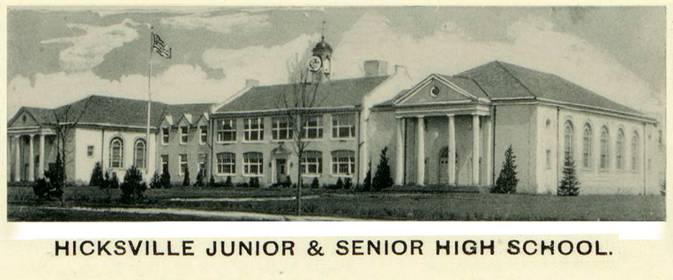
As this awkwardly-retouched 1925 picture (note the painted-in clock) illustrates, the exterior of the finished building differs only subtly from the design originally presented. Differences include the lack of cupolas on the wings, slightly larger windows on the front facade, a more prominent tower, and a more massive character over all. Although the net effect is less delicate than the original concept, it is still attractive.
A setback occurred at the very end of the school's first December. According to the Long Islander, cold weather caused "every pipe" in the school to burst. The report contemplated only the anticipated plumbing bills. It did not mention any resultant water damage, nor any liability to be assumed by the architects or contractor, for failing to ensure that the pipes were adequately insulated from cold weather.
Built for a changing Hicksville, the school immediately triggered further change.
For example, although High School students in Hicksville had competed in other sports, organized football had never been played in the village. On September 20, 1925, the Eagle reported that Hicksville High School was organizing its first football team ever, and that its coach anticipated challenges, primarily because almost no one on his fledgling squad had ever played football! This inexperience was glaringly evident a few weeks later, when the Times reported that Manhasset had defeated Hicksville, 58-0.
Moreover, the school sparked further development of Hicksville, especially in the neighboring open land which had adjoined the site on 3 sides. As the building neared completion, so did new houses. It was a great advantage to Hicksville parents if they lived near the High School with its generous playing field, where even young children could play safely in the summer. Real estate listings like this one from June 1926 were sure to emphasize proximity to the school grounds:
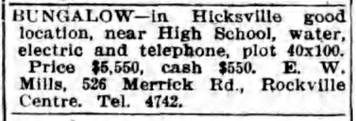
Although the High School momentarily brought Hicksville up to date, it immediately encouraged the long-term growth that would necessitate its own replacement 30 years later - but that's another story.
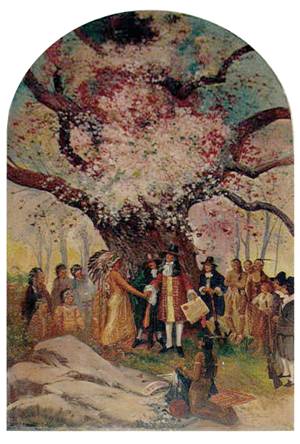
Post Script
The familiar murals in the auditorium (including Early Hicksville, right, which depicts Robert Williams' land purchase of 1648) were not part of the original building. They were painted in 1936 by Joseph Allen Physioc, as part of a Works Progress Administration project. One can learn more about the building's "New Deal Murals" at http://www.wpamurals.com/hicksvil.htmmural

